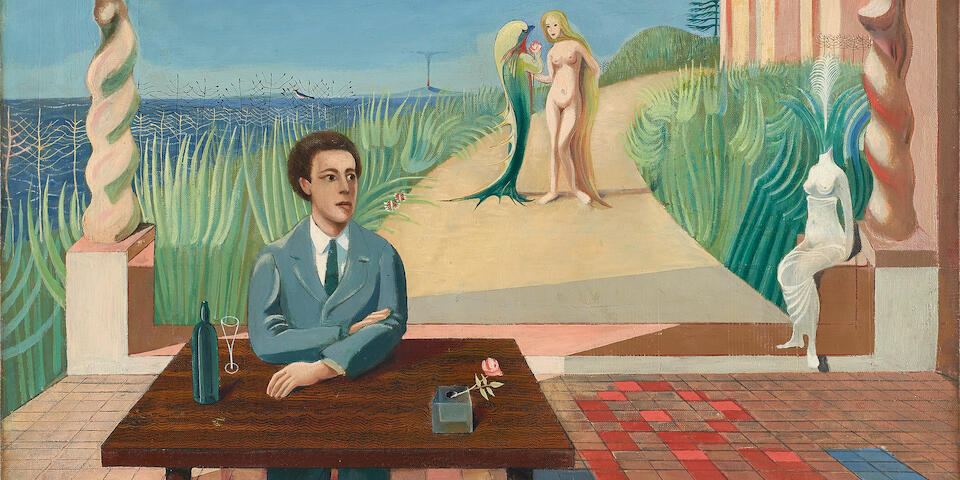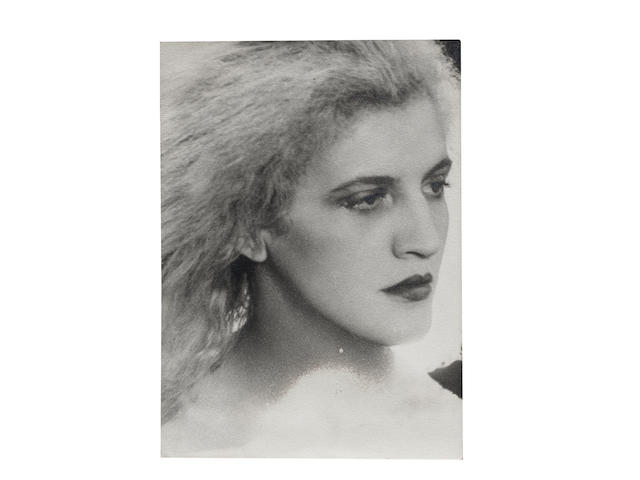
Paris – Portrait d'André Breton by Max Ernst (1891-1976) and his then-wife Marie-Berthe Aurenche (1906-1960), leads Bonhams La Révolution Surréaliste sale on 29 March in Paris. The rare joint work by the pair has an estimate of €400,000 - 600,000. Following the outstanding results for Bonhams' latest sales dedicated to Surrealism in 2021 and 2022 in London, Bonhams is delighted to present the third iteration of the auction, La Révolution Surréaliste, in the birthplace of the movement: Paris.
Emilie Millon, Bonhams Head of Impressionist & Modern Art in Paris, commented: "La Révolution surréaliste was a publication edited by the Surrealists in Paris between 1924 and 1929. In the early issues, it contained, among other things, dream stories by Breton, Raymond Queneau and Michel Leiris. Following successes with female Surrealist art and timed to coincide with the Surrealist Women exhibition at the Musée de Montmartre, we are excited to present La Révolution Surréaliste in Paris, the birthplace of this storied movement.
"We are also delighted to be offer a rare Portrait d'André Breton by Max Ernst and Marie-Berthe Aurenche. The women of the Surrealist movement long received more recognition for their role as muses than as artists in their own right. Max Ernst in particular developed a number of passionate relationships with talented and creative women – including Leonora Carrington, and Dorothea Tanning – and yet perhaps the most overlooked has been Marie-Berthe Aurenche. The story of this work offers a glimpse into how women have often been written out of the movement, and how they have only recently found their way back in."
Max Ernst met painter Marie-Berthe Aurenche in late 1927 and they married almost immediately. Photographed by Man Ray in 1928, they mixed with the wider group of Surrealists, including the leading figure of the group, André Breton. Breton and Ernst were already firm friends, but Breton disliked Marie-Berthe – allegedly telling Ernst that she acted like his nanny. The couple's joint portrait of Breton blends both their styles, yet the authorship of the work was originally misattributed. When the portrait was shown at the 1933 exhibition at the Galerie Pierre Colle, Marie-Berthe was named in the catalogue as the sole artist. Breton himself surprisingly attributed the work only to her in the May 1933 issue of his periodical Le surréalisme au service de la revolution, but by 1960 altered this to credit both her and Ernst.
Just five years later, Marie-Berthe was to be written out of the history of the work altogether – in his 1965 publication Érotique du surrealisme, Robert Benayoun annotated an illustration of Portrait d'André Breton as such: 'according to André Breton this painting was actually painted by Max Ernst himself'. Aurenche was removed from the creation of the work again in the catalogue for its 2004 exhibition in La Coruña, where it is attributed solely to her husband.
Ernst and Aurenche became estranged and divorced in 1936. She went on to become the mistress of the painter Chaïm Soutine in 1940. Marie-Berthe suffered from delusions, but not much else is known about her. After her death in 1960 she was buried in the same grave as Soutine.
Writing in Bonhams Magazine, Mark Hudson, states: "The anomalous calm of the painting's composition and atmosphere feel, then, very much Aurenche's creation. Rather than dominating the proceedings with his monstrous ego, Breton sits calmly at a table in the painting's middle ground, on a tiled terrace before a sun-drenched Mediterranean headland. Surreal beings, including a naked blonde woman and a bird-fish figure, both believed to be by Ernst, confer on a path far behind Breton, while a headless woman sits on a pediment beside one of two twisting columns. Yet these presences aren't ominous, as we'd expect in a painting entirely by Ernst: the headless figure feels more statue than cadaver."
Other highlights of the sale include:
• Léon Arthur Tutundjian (1906-1968), Masque jaune, 1930. Estimate : €120,000-180,000. The artist emigrated in 1923 to Paris where he befriended his fellow Armenian painter Ervand Kochar, who introduced him to Miró, Picasso, Mondrian and Jacques Villon. The present work dates from Tutundjian's Surrealist period, when, inspired by the works of René Magritte and Salvador Dalí, the artist developed his own visual metaphors often imbued with subtle Indian and Persian influences. Although never becoming a formal member of the Surrealist group, the artist was closely associated with André Breton and exhibited with the Surrealists throughout the 1940s and 1950s.
• Jane Graverol (1905-1984), Le Trait de Lumière, painted in 1959. Estimate : €35,000-55,000.
• Salvador Dalí (1904-1989), Rosa e morte floriscens, executed in 1967. Estimate: €40,000-60,000.
• Salvador Dalí (1904-1989), Study for the Marsupial Centurion, executed in 1941. Estimate: €15,000-20,000.
• Man Ray (1890-1976), La bonne route, oil on canvas laid on Masonite painted in 1953. From the collection of his celebrated model, Jacqueline Barsotti-Goddard, collection. Estimate: €8,000-12,000.

Paris - La Révolution Surréaliste sale at Bonhams Cornette de Saint Cyr on 29 March 2023 in Paris will offer a wide selection of European paintings and works of art from the surrealist movement. Among the highlights are photographs by Man Ray from the Collection of Jacqueline Barsotti-Goddard, showcasing his unique experimental photography skills and technique. Completely fresh to the market and previously unseen in public, the collection was gifted by Man Ray to Jacqueline over the course of many years in recognition of their long friendship and creative collaborations.
Man Ray (1890-1976), an American visual artist who lived mainly in Paris, was one of the first exponents of Dada in New York in the 1910s. Dadaism's eccentricity and irrationality gave way to Surrealism's fantasy and incongruity not long after he arrived in Paris in 1921. Man Ray carved out a place for himself in the Surrealist group by his inventive use of the photographic medium, giving the movement a distinctive visual identity that was deeply rooted in literary and psychoanalytic philosophy. Classified as "the poet who writes with light", he has "the head of a magic lantern", according to André Breton – whose portrait, a solarised gelatin silver print, is featured in the forthcoming auction (estimate: €10,000-15,000).

Man Ray, Untitled (André Breton), circa 1929. Estimate: €10,000-15,000. Photo: Bonhams
Man Ray played with the photographic medium and photographed his muse Jacqueline Goddard many times. Some of these portraits are part of the Parisian sale such as an early 1930s work, Portrait of Jacqueline (estimate: €8,000-12,000) or a Portrait of Lee Miller, his former mistress, a solarised gelatin silver contact print, is also offered for sale with an estimate of €7,000-10,000.
Hannah Noel-Smith, Head of UK & Europe Impressionist & Modern Art, commented: "We are delighted to be offering this group of works from Jacqueline's personal collection. Completely fresh to the market and previously unseen in public, the collection was gifted by Man Ray to Jacqueline over the course of many years in recognition of their long friendship and creative collaborations."
Born to a French mother and an Italian father, Jacqueline Goddard, born Barsotti (1911-2003), arrived in Montparnasse at the age of 17. She frequented La Coupole and other Parisian venues of the fashionable artists. She became a close friend of Man Ray and his former mistress Kiki de Montparnasse and met artists such as Alberto Giacometti, Pablo Picasso, and Henri Matisse, and writers including Georges Simenon – who used Jacqueline as a character in one of his novels, (and whom she notably disliked). Jacqueline had a distinctively modern look, with a Grecian profile, long neck and cropped, tousled hair. As her beauty was legendary in Montparnasse, she became a favoured artist's model in Paris during the 1920s and 1930s. Known as the 'Muse of Muses', she worked closely with Léonard Foujita, André Derain, Moïse Kisling, Picasso, Matisse, and Giacometti.
Jacqueline was one of the key female figures of the École de Paris and emerging Surrealist movement, enjoying mutually creative partnerships with the artists that she modelled for. One of Jacqueline's most productive partnerships was with the American artist, Man Ray. They met at the end of the 1920s when Man Ray asked Jacqueline to star as the heroine of a short film he was producing. Jacqueline would go on to become one of his preferred subjects and is immortalised in many of his most famous photographs. In one instance, Jacqueline was the person who actually pressed the button of the camera for Man Ray's iconic Suicide self-portrait of 1932. In a dedication to Jacqueline many years later, Man Ray wrote the following:
"To the most beautiful girl I have ever photographed.
Not true and not flattering to the others,
To the only one I did not sleep with.
Too compromising for the others who may have done so.
To the most inspiring one?
A compliment for me, but a perfect way of being rude to others.
You read this then, With all my love." Man Ray
Man Ray could not be satisfied with a single career, he was a hybrid artist. "In whatever form it is finally presented, by a drawing, by a painting, by a photograph, or by the object itself in its original material and in its original dimensions, it is designed to amuse, bewilder, annoy or to inspire reflection, but not to arouse admiration for any technical excellence usually sought for in works of art" said Man Ray in 1944.
In addition to Man Ray's photographs from the collection of Jacqueline Barsotti-Goddard, the La Révolution Surréaliste sale will showcase etchings, drawings, and paintings by Man Ray, such as

La bonne route, an oil on canvas laid on Masonite painted in 1953 by the artist (estimate: €8,000-12,000). Other highlights include Pain peint, an exhibition catalogue from 1973 with an estimate of €2,500-3,500 and Les mains libres, first edition, limited to 650 copies, presentation copy inscribed by the artist from 1937 by Man Ray and Paul Eluard, with an estimate of €2,000-3,000.